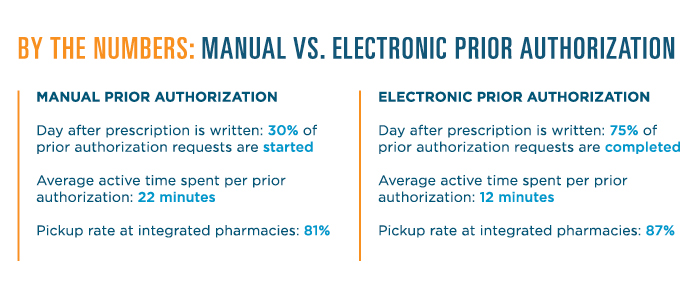Can we all agree that traditional prior authorization takes too much time and effort?
A few months ago, after switching jobs and insurance providers, a friend of mine realized one of her prescriptions had expired. She figured a simple call to her doctor’s office and a quick trip to the pharmacy were in order.
When she got to the pharmacy, however, it turned out the medication required prior authorization. To make matters worse, it wasn’t on the insurance plan’s formulary, three months’ worth totaled over $1,000, and there wasn’t an equally effective alternative.
The reality of traditional prior authorization is this: While the prescriber, the PBM and the pharmacy team spend valuable time making phone calls, tracking down information and filling out forms, the patient waits. And waits. And waits. In other words, patients face delays in receiving their prescriptions, clinicians lose valuable time and the health system faces mounting overtime costs.
With electronic prior authorization, the end result may have been the same for my friend but the experience would have been much better for all involved.
So what exactly is electronic prior authorization? The simple answer is this: it’s a process that delivers real-time prior authorization approvals directly from PBMs and health plans within the EHR workflow.
Aurora Health Care (now part of Advocate Aurora Health), decided it was time to transform their medication prior authorization process. To do so, they chose Surescripts Electronic Prior Authorization, which integrated easily into their existing EHR workflow, and they implemented a centralized process to manage all prior authorizations for medications system-wide. In two short months, Aurora saw tremendous results:
- Reduced clinic staff overtime by 51%
- Cut 10 minutes of active work time from the average prior authorization
- Reduced prior authorization wait time by more than two days
- Improved medication pickup rates at integrated pharmacies by six percentage points
"Repeatedly, we heard that patient messages and calls were handled much more quickly because [clinicians] weren’t stuck on the phone with insurance companies as much," said Manager of Specialty Pharmacy Dalia Saleh, one of the project leaders. "The other thing we heard was that staff were leaving on time."
Through no fault of their own, it was taking 3.8 days for Aurora clinic nurses to even begin working on a prior authorization.
After implementing the solution, that number decreased by nearly two-thirds.
Dramatic difference, right?
“Surescripts was brilliant in working with us throughout the implementation—they were incredibly helpful.”
Phillip Kissack
Senior Project Manager, Aurora Health Care
Electronic prior authorization starts as soon as the prescriber enters the prescription in the EHR. The Aurora clinicians are notified of the payer’s response within the same workflow, and approved prescriptions go directly to the pharmacy.
“It saves a significant amount of time—up to 45 minutes per medication authorization in some cases,” said Jennifer Kohlbeck, supervisor of Clinic Operations. “The electronic prior authorization process decreases the amount of chasing, multiple attempts to fax and chart review for the nursing staff.”

For those of you who are curious, my friend did, in fact, receive her medication but she never recovered any of the time spent waiting at the pharmacy for her prescription.
To find out how your organization can achieve impressive results by implementing Surescripts Electronic Prior Authorization, visit surescripts.com/priorauth.
Watch the Webinar: Implementing Centralized Electronic Prior Authorization


 Dean Riggott Photography
Surescripts
Dean Riggott Photography
Surescripts






